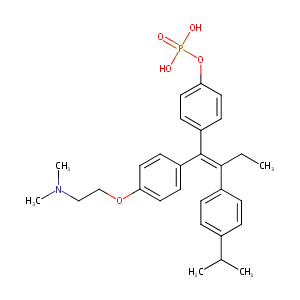| 2 |
Estrogen agonistic/antagonistic effects of miproxifene phosphate (TAT-59)Shibata J1, Toko T, Saito H, Lykkesfeldt AE, Fujioka A, Sato K, Hashimoto A, Wierzba K, Yamada Y.Author information1Hanno Research Center, Taiho Pharmaceutical Co., Ltd., 1-27 Misugidai, Hanno-City, Saitama, 357-8527, Japan.Erratum inCancer Chemother Pharmacol 2000;46(2):172. AbstractPURPOSE: We evaluated miproxifene phosphate (TAT-59) to elucidate its efficacy in antiestrogen therapy for breast cancer patients and to assess its tissue-selective estrogenic/antiestrogenic activity.METHODS: Using DP-TAT-59, a major and active metabolite of TAT-59, an in vitro cell growth inhibition test was performed. Antitumor activity was determined using TAT-59 against human tumor xenografts of the MCF-7 and the Br-10 cell lines andMCF-7-derived tamoxifen-resistant cell lines, R-27 and FST-1. The antitumor activity of DP-TAT-59 and DM-DP-TAT-59, major metabolites of TAT-59 found in human blood following a TAT-59 dose, was also examined after intravenous administration to experimental animals. The residual estrogenic activity of TAT-59, evaluated in terms of bone and lipid metabolism in ovariectomized rats, was then comparedwith that of tamoxifen.RESULTS: DP-TAT-59 significantly inhibited the proliferation of estrogen receptor-positive MCF-7 and T-47D tumor cells in the presence of 1 nM estradiol. TAT-59, given to mice bearing MCF-7 or Br-10 xenografts, at the dose level of 5 mg/kg, exerted a significant growth inhibitory effect that was stronger than that of tamoxifen. Moreover, R-27 and FST-1 tumors, which show a resistance to tamoxifen, responded strongly to TAT-59, suggesting that TAT-59 might be effective against tumors resistant to tamoxifen. The metabolites of TAT-59, DP-TAT-59 and DM-DP-TAT-59, showed similar antitumor activity. Both TAT-59 and tamoxifen suppressed the decrease in bone density and reduced the blood cholesterol levels in ovariectomized rats, suggesting that the estrogenic activity of TAT-59 is comparable to that of tamoxifen.CONCLUSIONS: On the basis of the above results, one may expect TAT-59 to become an effective drug in patients with tumors less sensitive to tamoxifen, while its estrogenic activity as determined by bone and lipid metabolism is similar to that of tamoxifen.PMID: 10663628 [PubMed - indexed for MEDLINE] ShareMeSH Terms, SubstancesMeSH TermsAnimalsAntineoplastic Agents, Hormonal/pharmacologyBreast Neoplasms/pathology*Cell Division/drug effectsDrug Screening Assays, AntitumorEstradiol/pharmacologyEstrogen Antagonists/pharmacology*FemaleHumansLipid MetabolismMiceMice, Inbred BALB CRatsRats, Sprague-DawleyReceptors, Estrogen/physiologyTamoxifen/analogs & derivatives*Tamoxifen/pharmacologyTransplantation, HeterologousTumor Cells, Cultured/drug effectsSubstancesAntineoplastic Agents, HormonalEstrogen AntagonistsReceptors, EstrogenTamoxifenTAT 59EstradiolLinkOut - more resourcesOther Literature SourcesAccess more work from the authors - ResearchGateMedicalBreast Cancer - MedlinePlus Health InformationMiscellaneousESTRADIOL - Hazardous Substances Data BankTAMOXIFEN - Hazardous Substances Data BankPubMed Commons home Cancer Chemother Pharmacol. 2000;45(2):133-41.
|


